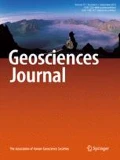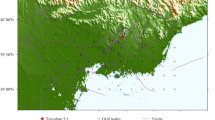Abstract
Based on the 4415 earthquakes body wave arrival times recorded by the 47 fixed and 33 temporary stations in Tangshan and its surrounding areas, the Tangshan fault’s area focal parameters and three-dimensional fine velocity structure model were inversed by using the consistency-constrained double-difference tomography method. The results revealed that the relocated earthquakes were roughly vertical to the fault’s strike, with the maximum depth exceeding 25 km. The Tangshan fault’s area Vp, Vs and Vp/Vs values demonstrate obvious inhomogeneity, and high speed bodies prone to the brittle fault are dominant on both sides of the fault in the upper crust. Small low velocity bodies appeared initially at the Ms7.8 Tangshan earthquake source in the 14–16 km range of the middle crust, followed by a gradual expansion of the low velocity area with an increase in depth. Variation in the velocity structure below the Tangshan earthquake source shows that the high temperature mantle source invading the crust has weakened the upper crust’s high-speed area, leading to stress accumulation in the local area, which is an important factor for the occurrence of earthquakes in the Tangshan region. The relationship between the regional seismic structure and Tangshan seismic sequence, causing migration of surrounding blocks and seismic activity in recent years was analyzed based on the Tangshan fault’s 3D highresolution velocity structure imaging. It is considered that the Tangshan area unique velocity structure not only plays a pivotal role in promoting horizontal tectonic stress during seismic activity, but is also the root cause of the aftershock evolution process and the fault’s morphological characteristics.
Similar content being viewed by others
References
Chen, Y.T., Huang, L.R., Lin, B.H., Liu, M.L., and Wang, X.H., 1979, A dislocation model of the Tangshan earthquake of 1976 from the inversion of geodesic data. Chinese Journal of Geophysics, 22, 201–217.
Chen, Y., Tsoi, K.L., Chen, F.B., Gao, Z.H., Zou, Q.J., and Chen, Z.L., 1988, The Great Tangshan Earthquake of 1976: An Anatomy of Disaster. Pergamon Press, Oxford, 153 p.
Duan, Y.H., Wang, F.Y., Zhang, X.K., Lin, J.Y., Liu, Z., Liu, B.F., Yang, Z.X., Guo, W.B., and Wei, Y.H., 2016, Three dimensional crustal velocity structure model of the middle-eastern North China Craton (HBCrust 1.0). Science China Earth Science, 59, 1477–488.
Eberhart-Phillips, D. and Michael, A.J., 1998, Seismotectonics of the Loma Prieta, California, region determined from three-dimensional Vp, Vp/Vs, and seismicity. Journal of Geophysical Research Solid Earth, 103, 21099–21120.
Guo, H., Zhang, H.J., and Fromentb, B., 2018, Structural control on earthquake behaviors revealed by high-resolution Vp/Vs imaging along the Go far transform fault, East Pacific Rise. Earth and Planetary Science Letters, 499, 243–255.
Hu, M.Q., Deng, Z.H., Lu, Y.Z., Song, J., Lu, Y., Zhu, X.Y., and Sun, F., 2014, Contemporary tectonic deformation in North China by using three-dimensional simulation. Seismology and Geology, 36, 148–165.
Huang, J.L. and Zhao, D.P., 2005, Fine three-dimensional P-wave velocity structure beneath the capital region and deep environment for the nucleation of strong earthquakes. Chinese Science Bulletin, 50, 544–552.
Huang, J.L. and Zhao, D.P., 2009, Seismic imaging of the crust and upper mantle under Beijing and surrounding regions. Physics of the Earth and Planetary Interiors, 173, 330–348.
Lai, X.L. and Sun, Y., 2013, Study on 3-D velocity structure by temporary dense seismostations networks of Tangshan earthquake region. Journal of Geodesy and Geodynamic, 33, 1–4.
Lei, J.S., Xie, F.R., Lan, C.X., Xing, C.Q., and Ma, S.Z., 2008, Seismic images under the Beijing region inferred from P and PmP data. Physics of the Earth and Planetary Interiors, 168, 134–146.
Li, Z.W., Hao, T.Y., and Xu, Y., 2011, Uppermost mantle structure of the North China Craton: constraints from interstation Pn travel time difference tomography. China Science Bulletin, 56, 1691–1699.
Li, Z.W., Ni, S.D., Roecker, S., Bao, F., Wei, X., and Yuen, D.A., 2018, Seismic imaging of source region in the 1976 MS 7.8 Tangshan earthquake sequence and its implications for the seismogenesis of intraplate earthquakes. Bulletin of the Seismological Society of America, 108, 1302–1313.
Li, Q.Z., Zhang, Z.L., Jin, Y.M., Yu, X.C., and Li, Z.Y., 1980, Focal mechanisms of Tangshan earthquakes. Seismology and Geology, 2, 59–66.
Lin, X.D., Yuan, H.Y., Xu, P., Yang, X., Xu, Z.G., Sun, H.X., Hou, L.J., Xu, S.T., and Xi, C.X., 2017, Zonational characteristics of earthquake focal mechanism solutions in North China. Chinese Journal of Geophysics, 60, 4589–4622.
Liu, B.J., Qu, G.S., Sun, M.X., Liu, K., Zhao, C.B., Xu, X.W., Feng, S.Y., and Kou, K.P., 2011, Crustal structures and tectonics of Tangshan earthquake area: results from deep seismic reflection profiling. Seismology and Geology, 33, 901–912.
Liu, M. and Stein, S., 2016, Mid-continental earthquakes: spatiotemporal occurrences, causes and hazards. Earth-Science Reviews, 162, 364–386.
Liu, Q.Y., Wang, J., Chen, J.H., Li, S.C., and Guo, B., 2007, Seismogenic tectonic environment of 1976 great Tangshan earthquake: results from dense seismic array observations. Earth Science Frontiers, 14, 205–213.
Ma, Y., Bi, J.M., and Gao, L., 2019, Three-dimensional velocity structure and tectonic characteristics of earthquake area in Yibin. Applied Geophysics, 16, 269–277.
Nabelek, J.L., Chen, W.P., and Ye, H., 1987, The Tangshan earthquake sequence and its implications for the evolution of the North China Basin. Journal of Geophysical Research, 921, 12615–12628.
Robinson, R., 2005, Stress interactions within the Tangshan, China, earthquake sequence of 1976. Bulletin of the Seismological Society of America, 95, 2501–2505.
Shito, A., Matsumoto, S., Shimizu, H., Ohkura, T., Takahashi, H., Sakai, S., Okada, T., Miyamachi, H., Kosuga, M., Asano, Y., and Okubo, M., 2017, Seismic velocity structure in the source region of the 2016 Kumamoto earthquake sequence, Japan. Seismological Research Letters, 44, 7766–7772.
Stein, S. and Liu, M., 2009, Long aftershock sequences within continents and implications for earthquake hazard assessment. Nature, 462, 87–89.
Thurber, C.H., 1983, Earthquake locations and three-dimensional crustal structure in the Coyote Lake Area, central California. Journal of Geophysical Research, 88, 8226–8236.
Thurber, C.H., 1993, Local Earthquake tomography: velocities and VP/VS theory. In: Iyer, H.M. and Hirahara, K. (eds.), Seismic Tomography: Theory and Practice. Chapman and Hall, London, p. 563–583.
Wang, C.Y., Wu, Q.J., Duan, Y.H., Wang, Z.S., and Lou, H., 2017, Crustal and upper mantle structure and deep tectonic genesis of large earthquakes in North China. Science China Earth Sciences, 60, 821–857.
Wang, W.L., Wu, J.P., and Fang, L.H., 2009, Crust and upper mantle S-wave velocity structure beneath Tanghai-Shangdu seismic array profile. Chinese Journal of Geophysics-Chinese Edition, 52, 81–89.
Wang, WL., Wu, J.P., and Fang, L.H., 2012, High resolution Rayleigh wave phase velocity tomography in northern North China. Geophysical Journal International, 189, 647–658.
Xin, H.L., Zhang, H.J., Kang, M., He, R.Z., Gao, L., and Gao, J., 2018, High-resolution lithospheric velocity structure of continental China by double-difference seismic travel time tomography. Seismological Research Letters, 90, 299–241.
Yin, A., Yu, X.J., Shen, Z.K., and Liu-Zeng, J., 2015, A possible seismic gap and high earthquake hazard in the North China Basin. Geology, 43, 19–22.
Zeng, R.S., Zhu, L.P., He, Z.Q., Ding, Z.F., and Sun, W.G., 1991, A seismic source model of the large earthquakes in North China extensional basin and discussions on the genetic processes of the extensional basin and earthquakes. Chinese Journal of Geophysics, 34, 288–301.
Zhang, S.C. and Diao, G.L., 1992, The tectonic process of the Tangshan earthquake sequence. Earthquake Research in China, 8, 73–80.
Zhang, Z.L., Li, Q.Z., Gu, J.C., Jin, Y.M., Yang, M.Y., and Liu, W.Q., 1980, The fracture processes of the Tangshan earthquake and its mechanical analysis. Acta Seismologica Sinica, 2, 111–129.
Zhang, H.J. and Thurber, C.H., 2003, Double-difference tomography: the method and its application to the Hayward fault, California. Bulletin of the Seismological Society of America, 93, 1875–1889.
Zhang, H.J., Thurber, C., and Bedrosian, P., 2009, Joint inversion for Vp, Vs, and Vp/Vs at SAFOD, Parkfield, California. Geochemistry Geophysics Geosystems, 10, 1–17.
Zhao, B., Gao, Y., and Shi, Y.T., 2013, Relocation of small earthquakes in North China using double difference algorithm. Earthquake, 33, 12–21.
Zhao, D.P., Hasegawa, A., and Horiuchi, S., 1992, Tomographic imaging of P and S wave velocity structure beneath northeastern Japan. Journal of Geophysical Research, 97, 19909–19928.
Acknowledgments
This work was supported by Seismic Regime Tracking Project of CEA (No. 2020010509) and Research Project of Tanjin Earthquake Agency (No. Zd202004). Thank Professor Haijiang Zhang and Doctor Hao Guo from the University of Science and Technology of China for his support and guidance in this research. The fixed station data in this paper is derived from the “Unified Formal Observation Report” provided by the “National Earthquake Cataloging System” of the China Earthquake Networks Center. The temporary station observation data is derived from Geophysical Exploration Center of China Earthquake Administration. Thanks to the reviewers for their suggestions and comments on this article.
Author information
Authors and Affiliations
Corresponding author
Additional information
Publisher’s Note
Springer Nature remains neutral with regard to jurisdictional claims in published maps and institutional affiliations.
Rights and permissions
About this article
Cite this article
Ma, Y., Gao, L. & Bi, J. Three-dimensional high-resolution velocity structure imaging and seismicity study of the Tangshan fault. Geosci J 25, 495–506 (2021). https://doi.org/10.1007/s12303-020-0036-5
Received:
Accepted:
Published:
Issue Date:
DOI: https://doi.org/10.1007/s12303-020-0036-5



